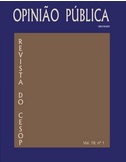Resumo
Este artigo analisa 156 pesquisas pré-eleitorais realizadas em 2010 nas disputas para Presidente e para os 27 governadores com o objetivo de descrever e explicar suas discrepâncias em relação aos resultados apurados nas urnas. O balanço utiliza o Método Mosteller 3 (MM3) para o cálculo do acerto agregado de cada pesquisa pré-eleitoral e sugere o Método de Estimação do Erro para cada Candidato (MEEC), com o propósito de investigar a existência de viés contra partido ou conjunto de partidos naquelas eleições. Os resultados revelam erros superiores às margens informadas à Justiça Eleitoral, mas não permitem condenar a precisão e a neutralidade partidária do conjunto das pesquisas analisadas. Maiores discrepâncias foram encontradas: i) em pesquisas realizadas com maior antecedência, ii) quando ainda no 1º turno, iii) em disputas pouco competitivas, (iv) quando havia poucos candidatos e v) nas eleições de governadores.
Abstract:
This article analyzes 156 pre-election surveys conducted in 2010 on candidates for President and Governor in the 27 Brazilian Federal Units. The main objective is to describe and explain differences between survey and ballot results. The study uses Mosteller’s Method 3 (MM3) to calculate the overall accuracy of each pre-election survey and suggests the Candidate Error Estimation Method (MEEC) to investigate a possible bias against a party or a group of parties during that election. The results show errors greater than that informed to Brazilian electoral authorities but do not justify calling into question the accuracy or partisan neutrality of the whole set of surveys analyzed. Greater differences were found: i) in surveys conducted many days before the vote, ii) during the first round, iii) in low competitive races, iv) when there were few candidates and v) in elections for Governor.
Keywords: 2010 Brazilian elections; pre-election surveys; methodology; error
Referências
ARTICLE 19. Comparative Study of Laws and Regulations Restricting the Publication of Electoral Opinion Polls [Online]. Article 19, 2003. Disponível em:<http://www.article19.org/data/files/pdfs/publications/opinion-polls-paper.pdf>. Acesso em: 26 jan. 2013.
BIEMER, P.P.; GROVES, R.M.; LYBERG, L.E.; MATHIOWETZ, N.A.;
SUDMAN, S. Measurement Errors in Surveys. New Jersey: John
Wiley & Sons, Inc, 2004.
CALLEGARO, M.; GASPERONI, G. “Accuracy of pre-election polls of the 2006 Italian Parliamentary Election: Too close to call”. International Journal of Public Opinion Research, Oxford, vol. 20, N˚ 2, p. 148-170, 2008.
CAVALLARI, M. “As pesquisas erraram?”. O Estado de S. Paulo, São Paulo, p. 2, 8 out. 2010.
COX, G. Making Votes Count: Strategic Coordination in the World´s Electoral System. Cambridge: Cambridge University Press, 1997.
CRESPI, I. Pre-election Polling: Sources of accuracy and error. Nova York: Russell Sage Foundation, 1988.
DURAND, C.; DESLAURIERS, M.; GOYDER, J.; FOUCAULT, M. “Why do polls go wrong sometimes?” Chicago. 65a Conferência da
AAPOR, 2010.
EL-DASH, N. A. “Avaliação das Pesquisas Eleitorais no Brasil (1989-2004)”. São Pedro. 19º Simpósio Nacional de Probabilidade e Estatística, 2010.
FIGUEIREDO, M. “Erros e acertos nas pesquisas eleitorais”. Folha de S. Paulo, São Paulo, p. Especial A7, 9 nov. 2002.
GROß, J. “Pre-Election Polling in Germany 1949-2005”. Trabalho apresentado na Universidade Internacional de Veneza, 2007.
MAGALHÃES, P.; MOREIRA, D. “As sondagens pré-eleitorais nas autárquicas de 2005”. Comunicação & Cultura, Lisboa, n˚ 3, p. 157-173. 2007.
MARTIN, E. A.; TRAUGOTT, M. W.; KENNEDY, C. “A Review and Proposal for a New Measure of Poll Accuracy”. Public Opinion Quarterly, Oxford, vol. 69, n° 3, p. 342-369, 2005.
MITOFSKY, W. J. “Was 1996 a Worse Year for Polls than 1948?”. Public Opinion Quarterly, Oxford, vol. 62, n° 2, p. 230- 249, 1998.
MOSTELLER, F. Measuring the error. In: MOSTELLER, F. H.; HYMAN, P. J.; MCCHARTY, E. S. MARKS & TRUMAN, D. B. (Eds.). The pre-election polls of 1948. Report to the committee on analysis and pre-election polls and forecast. New York: Social Science Research Council. p. 54-80, 1949.
SHIPMAN. S. J.; LEVE, J. H. “An Interval Measure of Election Poll Accuracy”. 2009. Disponível em <http://www.surveyusa.com/ROR/SurveyUSA%20Interval%20Measure%20of%20Election%20Poll%20Accuracy.html>. Acesso em: 26 jan. 2013.
TRAUGOTT, M. W. “The Accuracy of the National Preelection Polls in The 2004 Presidential Election”. Public Opinion Quarterly, Oxford, vol. 69, N˚ 5, Edição Especial 2005, p. 642-654, 2005.
VEJA. “Lula não fará seu sucessor ". 2009. Disponível em: <http://veja.abril.com.br/260809/lula-nao-fara-sucessor-p-072.shtml> Acesso em: 26 jan. 2013.
VEJA. “O Fracasso dos Profetas”, edição 2186, p. 72-75, 10 out. 2010. Acesso em: 26 jan. 2013.
A Opinião Pública utiliza a licença do Creative Commons (CC), preservando assim, a integridade dos artigos em ambiente de acesso aberto.

